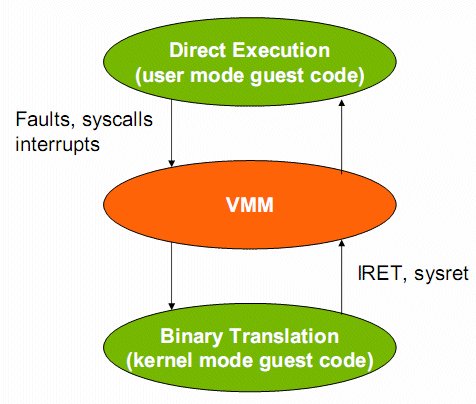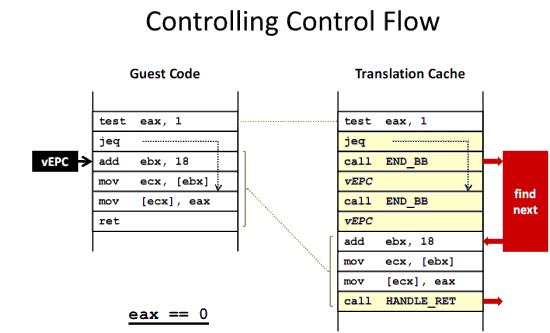Hardware Virtualization: the Nuts and Bolts
by Johan De Gelas on March 17, 2008 3:00 AM EST- Posted in
- IT Computing
Binary Translation
VMware didn't wait for Intel or AMD to solve the "x86 stealth instructions" problem and launched their solution at the end of the previous century (1999). To uncloak the stealthy x86 instructions, VMware used Binary translation (unfortunately, a Tachyon detection grid proved too expensive) . VMware's Binary Translation is a lot lighter than the binary translation technology that the Intel Itanium (x86 to IA64), Transmeta (x86 to VLIW), Digital FX!32 (Alpha to x86), or Rosetta software use. It doesn't have to translate from one Instruction Set Architecture (ISA) to another but it is based on an x86 to x86 translator. In fact, in some cases it just makes an exact copy of the original instruction.
VMware translates the binary code that the kernel of a guest OS wants to execute on the fly and stores the adapted x86 code in a Translator Cache (TC). User applications will not be touched by VMware's Binary Translator (BT) as it knows/assumes that user code is safe. User mode applications are executed directly as if they were running natively.

User applications are not translated, but run directly. Binary Translation only happens when the guest OS kernel gets called.
It is the kernel code that has go through the "x86 to slightly longer x86" code translation. You could say that the kernel of the guest OS is no longer running. The kernel code in the memory is nothing more than an input for the BT; it is the BT translated kernel that will run in ring 1.
In many cases, the translated kernel code will be an exact copy. However, there are several cases where BT must make the "translated" kernel code a bit longer than the original code. If the kernel of the guest OS has to run a privileged instruction, the BT will change this kind of code into "safer" user mode code. If the kernel needs to get control of the physical hardware, the BT will replace that binary code with code that manipulates the virtual hardware.

Binary translation from x86 to x86 virtualized in action. (Image: VMware[2])
Binary translation is all about scanning the code that the kernel of the guest OS should execute at a certain moment in time and replacing it with something safe (virtualized) on the fly. With "safe", we mean safe for the other guest OSes and the VMM. VMware also keeps the overhead of the translation as low as possible. The BT does not optimize the binary instruction stream, and an instruction stream that has been translated is kept in a cache. In case of a loop, this means that the translation is done only once.
The TC is not only a Translator Cache but also a bit of a Trace Cache as it keeps track of the control flow of the program. Each time the kernel jumps to another address location, the BT cannot copy this exactly. If the original code had to jump 100 bytes for example, it is very unlikely that the translated part of the kernel in the TC has to jump the same number of bytes. The BT has probably lengthened the "in between" code a bit.
It is clear that replacing code with "safer" code is a lot less costly than letting privileged instructions result in traps and then handling those traps afterwards. Nevertheless, that doesn't mean that the overhead of this kind of virtualization is always low. The "Translator overhead" is rather low, and its impact gets lower and lower over time, courtesy of the Translator cache. However, BT cannot completely crack several hard nuts:
- System
Calls
- Accesses to chipset and I/O, interrupts and DMA
- Memory management
- "Weird and complex code" (Self-modifying, indirect control flows, etc.)
Especially the first three are interesting. The last one is hard in an OS running in "native mode" too, so it is only normal that this doesn't get any better if you run more than one OS.










2 Comments
View All Comments
toony - Tuesday, March 20, 2012 - link
could you give me a analysis about EPT tech in detail or introduce me some reference about it? thx a lot...RogerAlvarado - Tuesday, August 3, 2021 - link
A deep shows changing for the approval of the phases for the field. The reforms of the https://softwaretested.com/technology/six-ways-sof... are met for the options. The theme is argued for the mid of the final mode for all affairs and activities for the visitors of the posts.